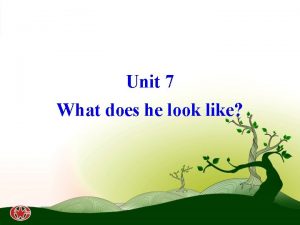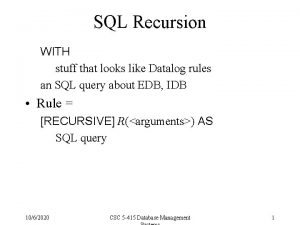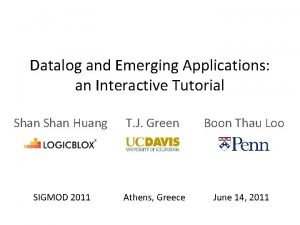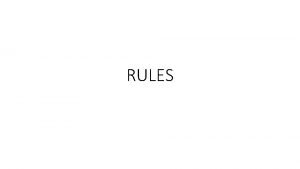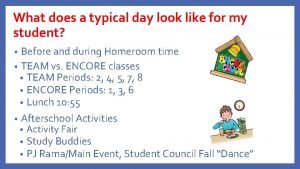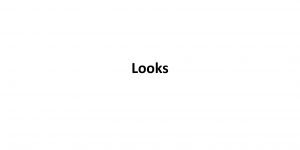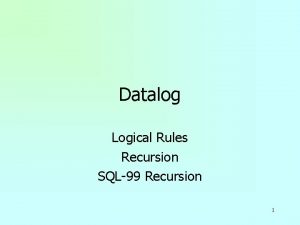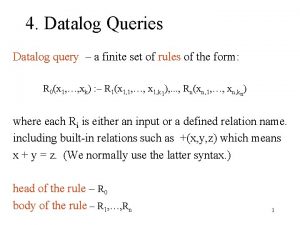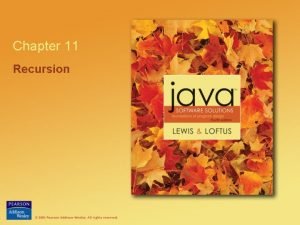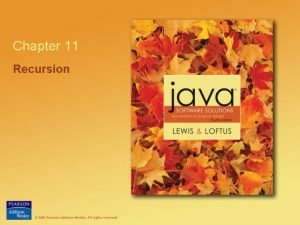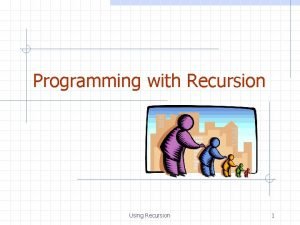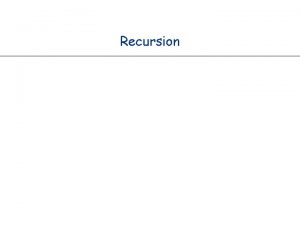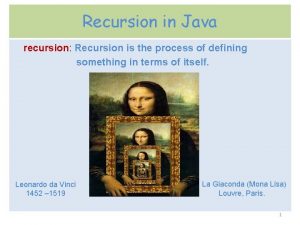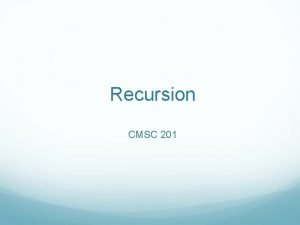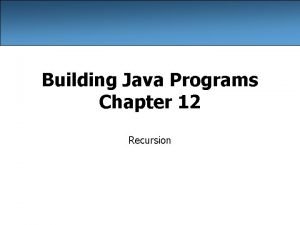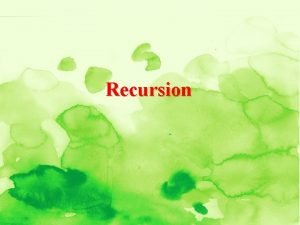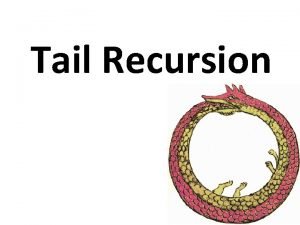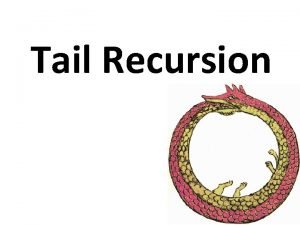SQL Recursion WITH stuff that looks like Datalog



















- Slides: 19

SQL Recursion WITH stuff that looks like Datalog rules an SQL query about EDB, IDB • Rule = [RECURSIVE] R(<arguments>) AS SQL query 10/6/2020 CSC 5 -415 Database Management 1

Example • Find Sally’s cousins, using EDB Par(child, parent). WITH Sib(x, y) AS SELECT p 1. child, p 2, child FROM Par p 1, Par p 2 WHERE p 1. parent = p 2. parent AND p 1. child <> p 2. child, RECURSIVE Cousin(x, y) AS Sib UNION (SELECT p 1. child, p 2. child FROM Par p 1, Par p 2, Cousin WHERE p 1. parent = Cousin. x AND p 2. parent = Cousin. y ) SELECT y FROM Cousin WHERE x = 'Sally'; 10/6/2020 CSC 5 -415 Database Management 2

Plan for Describing Legal SQL Recursion 1. Define “monotonicity, ” a property that generalizes “stratification. ” 2. Generalize stratum graph to apply to SQL queries instead of Datalog rules. u (Non)monotonicity replaces NOT in subgoals. 3. Define semantically correct SQL recursions in terms of stratum graph. Monotonicity If relation P is a function of relation Q (and perhaps other things), we say P is monotone in Q if adding tuples to Q cannot cause any tuple of P to be deleted. 10/6/2020 CSC 5 -415 Database Management 3

Monotonicity Example In addition to certain negations, an aggregation cause nonmonotonicity. Sells(dealer, car, price) SELECT AVG(price) FROM Sells WHERE dealer = 'Joe''s dealer'; • Adding to Sells a tuple that gives a new car Joe sells will usually change the average price of car at Joe’s. • Thus, the former result, which might be a single tuple like (2. 78) becomes another single tuple like (2. 81), and the old tuple is lost. 10/6/2020 CSC 5 -415 Database Management 4

Generalizing Stratum Graph to SQL • • • Node for each relation defined by a “rule. ” Node for each subquery in the “body” of a rule. Arc P Q if P is “head” of a rule, and Q is a relation appearing in the FROM list of the rule (not in the FROM list of a subquery), as argument of a UNION, etc. b) P is head of a rule, and Q is a subquery directly used in that rule (not nested within some larger subquery). c) P is a subquery, and Q is a relation or subquery used directly within P [analogous to (a) and (b) for rule heads]. a) • • Label the arc – if P is not monotone in Q. Requirement for legal SQL recursion: finite strata only. 10/6/2020 CSC 5 -415 Database Management 5

Example For the Sib/Cousin example, there are three nodes: Sib, Cousin, and SQ (the second term of the union in the rule for Cousin). Sib Cousin SQ • No nonmonotonicity, hence legal. 10/6/2020 CSC 5 -415 Database Management 6

A Nonmonotonic Example Change the UNION to EXCEPT in the rule for Cousin. RECURSIVE Cousin(x, y) AS Sib EXCEPT (SELECT p 1. child, p 2. child FROM Par p 1, Par p 2, Cousin WHERE p 1. parent = Cousin. x AND p 2. parent = Cousin. y ) Sib • Now, adding to the result of the subquery can delete Cousin facts; i. e. , Cousin is nonmonotone in SQ. • Infinite number of –’s in cycle, so illegal in SQL. 10/6/2020 CSC 5 -415 Database Management Cousin SQ 7

Another Example: NOT Doesn’t Mean Nonmonotone Leave Cousin as it was, but negate one of the conditions in the where-clause. RECURSIVE Cousin(x, y) AS Sib UNION (SELECT p 1. child, p 2. child FROM Par p 1, Par p 2, Cousin WHERE p 1. parent = Cousin. x AND NOT (p 2. parent = Cousin. y) ) • You might think that SQ depends negatively on Cousin, but it doesn’t. If I add a new tuple to Cousin, all the old tuples still exist and yield whatever tuples in SQ they used to yield. u In addition, the new Cousin tuple might combine with old p 1 and p 2 tuples to yield something new. u 10/6/2020 CSC 5 -415 Database Management 8

Object-Oriented DBMS’s • ODMG = Object Data Management Group: an OO standard for databases. • ODL = Object Description Language: design in the OO style. • OQL = Object Query Language: queries an OO database with an ODL schema, in a manner similar to SQL. 10/6/2020 CSC 5 -415 Database Management 9

ODL Overview Class declarations include: 1. Name for the interface. 2. Key declaration(s), which are optional. 3. Extent declaration = name for the set of currently existing objects of a class. 4. Element declarations. An element is an attribute, a relationship, or a method. 10/6/2020 CSC 5 -415 Database Management 10

ODL Class Declarations class <name> { elements = attributes, relationships, methods } Element Declarations attribute <type> <name>; relationship <rangetype> <name>; • Relationships involve objects; attributes involve non-object values, e. g. , integers. Method Example float gpa(in string) raises(no. Grades) • float = return type. • in: indicates the argument (a student name, presumably) is readonly. u Other options: out, inout. • no. Grades is an exception that can be raised by method gpa. 10/6/2020 CSC 5 -415 Database Management 11

ODL Relationships • Only binary relations supported. u Multiway relationships require a “connecting” class, as discussed for E/R model. • Relationships come in inverse pairs. u Example: “Sells” between cars and dealers is represented by a relationship in dealers, giving the cars sold, and a relationship in cars giving the dealers that sell it. • Many-many relationships have a set type (called a collection type) in each direction. • Many-one relationships have a set type for the one, and a simple class name for the many. • One-one relations have classes for both. 10/6/2020 CSC 5 -415 Database Management 12

cars-dealers-drivers Example class cars { attribute string name; attribute string manf; relationship Set<dealers> bought. At inverse dealers: : serves; relationship Set<drivers> fans inverse drivers: : likes; } • An element from another class is indicated by <class>: : • Form a set type with Set<type>. 10/6/2020 CSC 5 -415 Database Management 13

class dealers { attribute string name; attribute Struct Addr {string street, string city, int zip} address; attribute Enum Lic {full, car, none} license. Type; relationship Set<drivers> customers inverse drivers: : frequents; relationship Set<cars> serves inverse cars: : bought. At; } • Structured types have names and bracketed lists of field-type pairs. • Enumerated types have names and bracketed lists of values. 10/6/2020 CSC 5 -415 Database Management 14

class drivers { attribute string name; attribute Struct dealers: : Addr address; relationship Set<cars> likes inverse cars: : fans; relationship Set<dealers> frequents inverse dealers: : customers; } • Note reuse of Addr type. 10/6/2020 CSC 5 -415 Database Management 15

ODL Type System • Basic types: int, real/float, string, enumerated types, and classes. • Type constructors: Struct for structures and four collection types: Set, Bag, List, Array, and Dictionary. • Relationship types may only be classes or a collection of a class. 10/6/2020 CSC 5 -415 Database Management 16

Many-One Relationships Don’t use a collection type for relationship in the “many” class. Example: drivers Have Favorite cars class drivers { attribute string name; attribute Struct dealers: : Addr address; relationship Set<cars> likes inverse cars: : fans; relationship cars favoritecar inverse cars: : real. Fans; relationship Set<dealers> frequents inverse dealers: : customers; } • Also add to cars: relationship Set<drivers> real. Fans inverse drivers: : favoritecar; 10/6/2020 CSC 5 -415 Database Management 17

Example: Multiway Relationship Consider a 3 -way relationship dealers-cars-prices. We have to create a connecting class BBP. class Prices { attribute real price; relationship Set<BBP> to. BBP inverse BBP: : the. Price; } class BBP { relationship dealers thedealer inverse. . . relationship cars thecar inverse. . . relationship Prices the. Price inverse Prices: : to. BBP; } • Inverses for thedealer, thecar must be added to dealers, cars. • Better in this special case: make no Prices class; make price an attribute of BBP. • Notice that keys are optional. u BBP has no key, yet is not “weak. ” Object identity suffices to distinguish different BBP objects. 10/6/2020 CSC 5 -415 Database Management 18

Roles in ODL Names of relationships handle “roles. ” Example: Spouses and Drinking Buddies class drivers { attribute string name; attribute Struct dealers: : Addr address; relationship Set<cars> likes inverse cars: : fans; relationship Set<dealers> frequents inverse dealers: : customers; relationship drivers husband inverse wife; relationship drivers wife inverse husband; relationship Set<drivers> buddies inverse buddies; } • Notice that drivers: : is optional when the inverse is a relationship of the same class. 10/6/2020 CSC 5 -415 Database Management 19
 What does he look like
What does he look like What he looks like or how he looks like
What he looks like or how he looks like Datalog vs sql
Datalog vs sql To understand recursion you must understand recursion
To understand recursion you must understand recursion Datalog tutorial
Datalog tutorial Datalog
Datalog Datalog semantic web
Datalog semantic web Con hãy đưa tay khi thấy người vấp ngã
Con hãy đưa tay khi thấy người vấp ngã Thơ thất ngôn tứ tuyệt đường luật
Thơ thất ngôn tứ tuyệt đường luật Gây tê cơ vuông thắt lưng
Gây tê cơ vuông thắt lưng Tôn thất thuyết là ai
Tôn thất thuyết là ai Phân độ lown
Phân độ lown Walmart thất bại ở nhật
Walmart thất bại ở nhật Sau thất bại ở hồ điển triệt
Sau thất bại ở hồ điển triệt Block nhĩ thất độ 2 mobitz 1
Block nhĩ thất độ 2 mobitz 1 Tìm vết của đường thẳng
Tìm vết của đường thẳng Thơ thất ngôn tứ tuyệt đường luật
Thơ thất ngôn tứ tuyệt đường luật Nicotine look like
Nicotine look like Interrupted medulla
Interrupted medulla Levofen
Levofen
